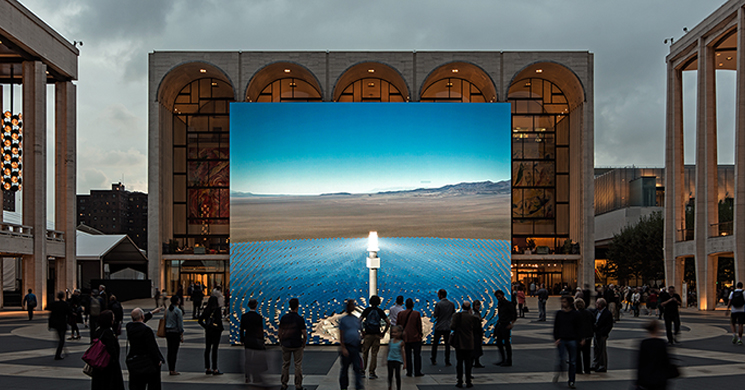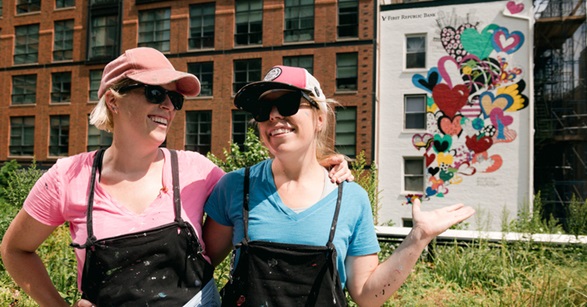VIA Art Fund brings artists, curators and patrons together as partners in a philanthropic fund to support innovative artistic endeavors focusing on contemporary visual art in the public realm. The nonprofit organization has awarded more than $3 million in grants to artists and cultural institutions since it was founded in 2013 — and shows no signs of slowing down.
We spoke with VIA co-founder and President Bridgitt Evans about the transformative power of public arts funding, ways to encourage diversity in a flourishing art scene and how philanthropic efforts have empowered arts enthusiasts to raise the bar and bridge existing funding gaps.
How could increased public support of the arts enhance the lives of all Americans?
We live in very tumultuous times, which makes art more important than ever. Art has the power to transform the way we see ourselves, each other and the world around us. Contemporary artists, in particular, are involved in exploring the issues of the day. Their art inspires creativity, encourages dialogue, helps to create a sense of community and ultimately creates and fosters a more overall just and civic society.
Sadly, within the U.S., we’ve experienced a severe decline in public funding for the arts since the mid-1990s, when funding for the National Endowment for the Arts (NEA) was first slashed by 40%. Since then, the NEA budget has remained a recurring target for lawmakers.
Despite the arts and creative industries contributing more than $750 billion to the U.S. economy, making up 4.2% of GDP, and employing 4.9 million workers, the arts are nevertheless seen as elitist and limited to select cities. Why? In part because a large portion of private foundation philanthropy is concentrated in just four states — New York, California, Texas and Illinois. There exists a huge gap in access to the arts in small and midsize communities. Without greater public funding, it’s up to individuals, foundations and organizations like ours to step in and bridge that gap.
How can philanthropy affect the proliferation of new art — particularly among traditionally underrepresented artist groups?
Philanthropy has been at the heart of art curation for centuries. Michael Govan, Director of the Los Angeles County Museum of Art (LACMA), recently pointed out that all 120,000 items in their collection are the direct result of philanthropy — either outright gifts or purchased through funds provided by patrons. Still, historically the artists who benefited from that patronage were highly reflective of those who held the social, political and economic power to support the arts.
With regard to museum acquisitions, both female artists and artists of color are greatly underrepresented. Now there is a focus on opening up and reimagining the dominant narrative of art history so that museum collections and programming are more diverse, inclusive and reflective of our society today.
VIA, as an organization, strives to open up that field. We want to be more inclusive and maintain a broader, more diverse array of patrons. We turn an eye toward funding the most compelling grants. During the past six years, we have built a reputation for supporting artists of color, women and those with more experimental and innovative practices. Our grantmaking is not informed by the historical biases you may see in most museum collections.
How does the VIA Art Fund model differ from the traditional model of arts philanthropy?
From the beginning, our primary goal has been to connect patrons and artists more directly. Traditionally, funding was concentrated around museums, which tend to have a high cost of entry for patrons for meaningful participation. We wanted to tap into the large philanthropic ecosystem that existed below the institutional echelon, and we wanted to do it without cannibalizing the existing flow of funds to our museums. We were trying to offer something different than what currently existed — and we succeeded.
At the same time, in cases where we are providing significant or all of the funding for a particular project, we earn the right to acquire and subsequently gift the work to a public museum collection. We support artists, but we support museums as well.
You have a robust background in finance and as a real estate developer. How has that background helped create success for VIA Art Fund?
When founding VIA, I was able to look at the philanthropic model through the lens of an investor. VIA, in concept, is not all that different from a comingled investment fund. We expand the reach of the arts community, and we diversify holdings.
We set about the idea of creating a collective — which is similar to developing a targeted fund for investors. We established an analytical framework encompassing a set of well-defined core values of Artistic Production, Thought Leadership and Public Engagement to assist us in deciding where to deploy funds.
In short, each patron donates $10,000 annually, becomes a partner in the fund and earns one vote. Patrons then participate democratically through our semiannual partnership meetings in which we hear directly from artists, curators or institutional leaders; debate the merits of each opportunity; and make funding decisions. Of course, we never have enough money to fund every project we believe has merit, so each partner’s voice matters.
In founding VIA, we developed an operating model to harness individual passion, pool resources and work together to write grants for production funding. Our contract with our fund partners is that if they invest their time and resources, we provide the opportunity for learning and engagement, not only through the grant vetting process but also through studio visits and artist-led tours once the project is realized.
How has your organization grown and changed over time?
Since our launch in 2013, the commitment to our funding ethos has never wavered. But we have expanded our grantmaking. Today we award grants in three categories:
First, Artistic Production Grants, which directly support artists creating innovative and impactful works of art for exhibition primarily in the public realm.
[Image: Yinka Shonibare MBE, The American Library, 2018. Installation view at The Cleveland Public Library. © Yinka Shonibare MBE. Commissioned by FRONT International: Cleveland Triennial for Contemporary Art. July 14- September 30, 2018. Courtesy James Cohan Gallery, New York and FRONT International: Cleveland Triennial for Contemporary Art with funds from VIA Art Fund, Cleveland Public Library and The City of Cleveland’s Cable Television Minority Arts and Education Fund. Photography by Field Studio.]
Second, Incubator Grants, which provide general operating support to small to midsize nonprofit organizations across the U.S. that champion new, diverse and/or overlooked artistic voices. In partnership with Wagner Foundation, we recently announced a 5-year, $1 million Incubator Grant Fund to promote work that penetrates social, cultural, economic and geographic barriers and acts as a platform for meaningful collective public experiences. Through this fund, we plan to focus our grantmaking to organizations outside the traditionally-existing hubs for art.
And, finally, the VIA Curatorial Fellowship, an annual grant supporting curation and thought leadership within the field by awarding a midcareer curator unrestricted travel and research funding.
We began locally in Boston; our very first meeting was held at a small First Republic conference room on Boylston Street. Today we have more than 60 partners within the U.S. and several overseas, and we are grateful to First Republic for jumping in from the very beginning and offering to facilitate our idea of creating a national working group and a new tranche of philanthropy for the visual arts.
Is there something from your model that other organizations can learn from or use to enhance their own missions?
The patron-as-partner model has been powerful for us. In an industry where measuring impact is not readily accessible, you have to bring the work to life. At VIA, we’ve tapped into the passion of art enthusiasts and opened them up to great ideas, great artists and great projects. Cultivating and educating your donors is key, whether you’re in the arts or another sector — at VIA, we have the benefit of being a peer-to-peer organization founded by myself, from the perspective of a donor, to align with other donors.
Our grant-making decisions are made by the partnership in a very transparent and democratic way; because each partner has one vote, this more open, decentralized process allows room for diverse thoughts and opinions.
If you can give your donors agency or ownership, do it. It may not make sense for all organizations to share the level of decision-making that we do, but it’s worth it in terms of loyalty. We raise our funds at the beginning of every calendar year and have minimal turnover. At the end of each year we prepare an impact report of what we’ve accomplished. Our donors are constantly engaged with our work.
We look forward to continuing to work with both individuals and foundations to offer more grant categories and more funding that will allow us to promote and support the innovative and compelling artists, curators and art of our time.





